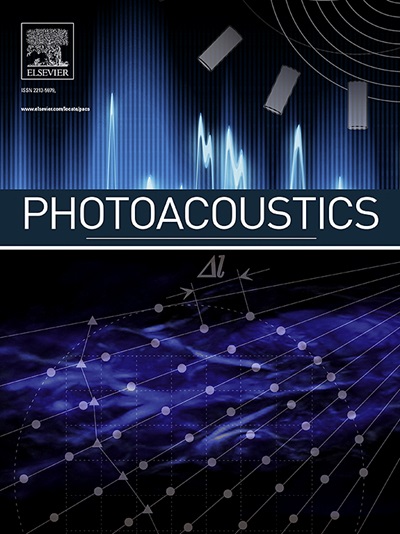Magneto-photoacoustic coupling: A pathway to optical-resolution electrical conductivity imaging
IF 6.8
1区 医学
Q1 ENGINEERING, BIOMEDICAL
引用次数: 0
Abstract
Electrical conductivity is a critical biomarker for cellular activity and a fundamental parameter in material science. However, achieving label-free, contact-free conductivity measurements with optical-scale resolution remains a challenge. Here, we introduce a magneto-photoacoustic coupling effect that enables conductivity mapping through photoacoustic excitation in the presence of a static magnetic field. The governing equation for this phenomenon is derived, demonstrating a linear relationship between the induced photoacoustic pressure and the product of the local magnetic flux density squared and electrical conductivity. This theoretical framework is further validated using numerical simulation, which showcases the method’s capability for optical-resolution conductivity imaging. The proposed approach unlocks new opportunities for applications ranging from real-time tracking of neuronal ion channel dynamics to nanoscale defect characterization in metallic and semiconductor materials.
磁光声耦合:实现光学分辨率电导率成像的途径
电导率是细胞活性的重要生物标志物,也是材料科学的基本参数。然而,实现光学尺度分辨率的无标签、无接触电导率测量仍然是一个挑战。在这里,我们介绍了磁光声耦合效应,使电导率映射通过光声激发在静态磁场的存在。推导了这一现象的控制方程,证明了感应光声压与局部磁通密度平方和电导率的乘积之间的线性关系。通过数值模拟进一步验证了该理论框架,证明了该方法具有光学分辨率电导率成像的能力。所提出的方法为从实时跟踪神经元离子通道动力学到金属和半导体材料的纳米级缺陷表征等应用提供了新的机会。
本文章由计算机程序翻译,如有差异,请以英文原文为准。
求助全文
约1分钟内获得全文
求助全文
来源期刊

Photoacoustics
Physics and Astronomy-Atomic and Molecular Physics, and Optics
CiteScore
11.40
自引率
16.50%
发文量
96
审稿时长
53 days
期刊介绍:
The open access Photoacoustics journal (PACS) aims to publish original research and review contributions in the field of photoacoustics-optoacoustics-thermoacoustics. This field utilizes acoustical and ultrasonic phenomena excited by electromagnetic radiation for the detection, visualization, and characterization of various materials and biological tissues, including living organisms.
Recent advancements in laser technologies, ultrasound detection approaches, inverse theory, and fast reconstruction algorithms have greatly supported the rapid progress in this field. The unique contrast provided by molecular absorption in photoacoustic-optoacoustic-thermoacoustic methods has allowed for addressing unmet biological and medical needs such as pre-clinical research, clinical imaging of vasculature, tissue and disease physiology, drug efficacy, surgery guidance, and therapy monitoring.
Applications of this field encompass a wide range of medical imaging and sensing applications, including cancer, vascular diseases, brain neurophysiology, ophthalmology, and diabetes. Moreover, photoacoustics-optoacoustics-thermoacoustics is a multidisciplinary field, with contributions from chemistry and nanotechnology, where novel materials such as biodegradable nanoparticles, organic dyes, targeted agents, theranostic probes, and genetically expressed markers are being actively developed.
These advanced materials have significantly improved the signal-to-noise ratio and tissue contrast in photoacoustic methods.
 求助内容:
求助内容: 应助结果提醒方式:
应助结果提醒方式:


